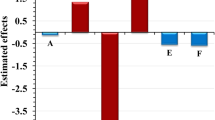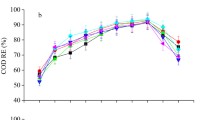Abstract
The current study focused on the pollution remediation of textile industry wastewater by using Chlorella pyrenoidosa in two different physical forms: free algal biomass and immobilized algal biomass. The hypothesis behind the present study was to analyze the pollution reduction efficiency of immobilized algal biomass and free algal biomass on comparative scale on the basis of the adsorption process which is directly proportional with the surface area of the adsorbate. So, in this context the immobilized form of algae could enhance the pollution reduction efficiency due to availability of more surface area. So, the textile industry wastewater was treated by both free algal biomass and immobilized algal biomass and the major wastewater contributors like nitrate, phosphate, Biochemical Oxygen Demand (BOD) and Chemical Oxygen Demand (COD) were assessed before and after the treatment process. To conclude the optimum comparative results, the pH of wastewater was maintained constant, as it can capitalize or moderate the adsorption process (initial pH of was 8.2 ± 0.1, but it was maintained to 8). The contamination remediation was found to be effective with immobilized algal biomass (46.7% of nitrate, 59.4% of phosphate, 83.1% BOD and 83.0% of COD) than free algal biomass (43.2% of nitrate, 56.7% of phosphate, 71.4% of BOD and 78.0% COD).


Similar content being viewed by others
References
APHA (2012) Standard methods for the examination of water and waste water, 22nd edn. American Public Health Association, Washington, DC
Aragaw TS, Asmare AM (2018) Phycoremediation of textile wastewater using indigenous microalgae. Water Practice Technology 13(2):274–284. https://doi.org/10.2166/wpt.2018.037
Bhatia D, Sharma NR, Singh J, Kanwar RS (2017) Biological methods for textile dye removal from wastewater: a review. Crit Rev Environ Sci Technol 47(19):1836–1876. https://doi.org/10.1080/10643389.2017.1393263
Bouabidi ZB, El-Naas MH, Zhang Z (2018) Immobilization of microbial cells for the biotreatment of wastewater: a review. Environ Chem Lett 17(1):241–257. https://doi.org/10.1007/s10311-018-0795-7
Brar A, Kumar M, Vivekanand V, Pareek N (2019) Phycoremediation of textile effluent contaminated water bodies employing microalgae: nutrient sequestration and biomass production studies. Int J Environ Sci Technol 16:7757–7768. https://doi.org/10.1007/s13762-018-2133-9
Cai T, Park SY, Li Y (2013) Nutrient recovery from wastewater streams by microalgae: status and prospects. Renew Sustain Energy Rev 19:360–369. https://doi.org/10.1016/j.rser.2012.11.030
Chen KC, Wu JY, Liou DJ, Hwang SCJ (2003) Decolorization of the textile dyes by newly isolated bacterial strains. J Biotechnol 101(1):57–68. https://doi.org/10.1016/S0168-1656(02)00303-6
Chia MA, Odoh OA, Ladan Z (2014) The indigo blue dye decolorization potential of immobilized Scenedesmus quadricauda. Water Air Soil Pollut 225(4):1920. https://doi.org/10.1007/s11270-014-1920-2
De-Bashan LE, Bashan Y (2010) Immobilized microalgae for removing pollutants: review of practical aspects. Bioresour Technol 101(6):1611–1627. https://doi.org/10.1016/j.biortech.2009.09.043
El-Kassas HY, Mohamed LA (2014) Bioremediation of the textile waste effluent by Chlorella vulgaris. Egypt J Aquat Res 40(3):301–308. https://doi.org/10.1016/j.ejar.2014.08.003
Gikoyon B (2013) Advances in biofuel production: algae and aquatic plants. CRC, New York
Guo J, Zhou J, Wang D, Tian C, Wang P, Salah Uddin M, Yu H (2007) Biocalalyst effects of immobilized anthraquinone on the anaerobic reduction of azo dyes by the salt-tolerant bacteria. Water Res 41(2):426–432. https://doi.org/10.1016/j.watres.2006.10.022
Hynes NRJ, Kumar JS, Kamyab H, Sujana JAJ, Al-Khashman OA, KUSLU Y, Suresh B (2020) Modern enabling techniques and adsorbents based dye removal with sustainability concerns in textile industrial sector: a comprehensive review. J Clean Prod 272:122636. https://doi.org/10.1016/j.jclepro.2020.122636
Jegatheesan V, Pramanik BK, Chen J, Navaratna D, Chang CY, Shu L (2016) Treatment of textile wastewater with membrane bioreactor: a critical review. Bioresour Technol 204:202–212. https://doi.org/10.1016/j.biortech.2016.01.006
Kaparapu J, Geddada MNR (2016) Applications of immobilized algae. J Algal Biomass Utili 7(2):122–128
Kilic NK, Nielsen JL, Yüce M, Dönmez G (2007) Characterization of a simple bacterial consortium for effective treatment of wastewaters with reactive dyes and Cr(VI). Chemosphere 67(4):826–831. https://doi.org/10.1016/j.chemosphere.2006.08.041
Kothari R, Pathak VV, Pandey A, Ahmad S, Srivastava C, Tyagi VV (2017) A novel method to harvest Chlorella sp. via low cost bioflocculant: Influence of temperature with kinetic and thermodynamic functions. Bioresour Technol 225:84–89. https://doi.org/10.1016/j.biortech.2016.11.050
Lee CS, Lee SA, Ko SR, Oh HM, Ahn CY (2015) Effects of photoperiod on nutrient removal, biomass production, and algal-bacterial population dynamics in lab-scale photo bioreactors treating municipal wastewater. Water Res 68:680–691. https://doi.org/10.1016/j.watres.2014.10.029
Lellis B, Fávaro-Polonio CZ, Pamphile JA, Polonio JC (2019) Effects of textile dyes on health and the environment and bioremediation potential of living organisms. Biotechnol Res Innov 3(2):275–290. https://doi.org/10.1016/j.biori.2019.09.001
Li K, Liu Q, Fang F, Luo R, Lu Q, Zhou W, Ruan R (2019) Microalgae-based wastewater treatment for nutrients recovery: a review. Bioresour Technol 191:121934. https://doi.org/10.1016/j.biortech.2019.121934
Lim SL, Chu WL, Phang SM (2010) Use of Chlorella vulgaris for bioremediation of textile wastewater. Bioresour Technol 101(19):7314–7322. https://doi.org/10.1016/j.biortech.2010.04.092
Majhi PK, Kothari R, Pandey A, Tyagi VV (2020) Adsorptive behavior of free and immobilized Chlorella pyrenoidosa for decolorization. Biomass Convers Biorefin. https://doi.org/10.1007/s13399-020-00770-6
Nguyen TQ, Sesin V, Kisiala A, Neil Emery RJ (2020) The role of phytohormones in enhancing metal remediation capacity of algae. Bull Environ Contam Toxicol 105:671–678. https://doi.org/10.1007/s00128-020-02880-3
Pandey A, Pathak VV, Kothari R, Black PN, Tyagi VV (2019) Experimental studies on zeta potntial of flocculants for harvesting of algae. J Environ Manag 231:562–569. https://doi.org/10.1016/j.jenvman.2018.09.096
Pathak VV, Kothari R, Chopra AK, Singh DP (2015) Experimental and kinetic studies for phycoremediation and dye removal by Chlorella pyrenoidosa from textile wastewater. J Environ Manag 163:270–277. https://doi.org/10.1016/j.jenvman.2015.08.041
Pathak AK, Kothari R, Tyagi VV, Anand S (2020) Integrated approach for textile industry wastewater for efficient hydrogen production and treatment through solar PV electrolysis. Int J Hydrog Energy 45(48):25768–25782. https://doi.org/10.1016/j.ijhydene.2020.03.079
Paździor K, Bilińska L, Ledakowicz S (2018) A review of the existing and emerging technologies in the combination of AOPs and biological processes in industrial textile wastewater treatment. Chem Eng J 376:120597. https://doi.org/10.1016/j.cej.2018.12.057
Saratale RG, Saratale GD, Chang JS, Govindwar SP (2011) Bacterial decolorization and degradation of azo dyes: a review. J Taiwan Inst Chem Eng 42(1):138–157. https://doi.org/10.1016/j.jtice.2010.06.006
Wang Y, Ho SH, Cheng CL, Guo WQ, Nagarajan D, Ren NQ, Chang JS (2016) Perspectives on the feasibility of using microalgae for industrial wastewater treatment. Bioresour Technol 222:485–497. https://doi.org/10.1016/j.biortech.2016.09.106
Whitton R, Ometto F, Pidou M, Jarvis P, Villa R, Jefferson B (2015) Microalgae for municipal wastewater nutrient remediation: mechanisms, reactors and outlook for tertiary treatment. Environ Technol Rev 4(1):133–148. https://doi.org/10.1080/21622515.2015.1105308
Wollmann F, Dietze S, Ackermann J, Bley T, Walther T, Steingroewer J, Krujatz F (2019) Microalgae wastewater treatment: biological and technological approaches. Eng Life Sci 19(12):860–871. https://doi.org/10.1002/elsc.201900071
Wu JY, Lay CH, Chen CC, Wu SY, Zhou D, Mohamed Abdula P (2020) Textile wastewater bioremediation using immobilized Chlorella sp. Wu-G23 with continuous culture. Clean Technol Environ Policy. https://doi.org/10.1007/s10098-020-01847-6
Yagub MT, Sen TK, Afroze S, Ang HM (2014) Dye and its removal from aqueous solution by adsorption: a review. Adv Coll Interface Sci 209:172–184. https://doi.org/10.1016/j.cis.2014.04.002
Yaseen DA, Scholz M (2018) Textile dye wastewater characteristics and constituents of synthetic effluents: a critical review. Int J Environ Sci Technol 16:1193–1226. https://doi.org/10.1007/s13762-018-2130-z
Acknowledgement
Mr. Pradeep Kumar Majhi, Senior Research Fellow (SRF) likes to acknowledge National Fellowship for Schedule Caste- University Grant Commission, Government of India for providing financial support. The authors would also like to acknowledge Laboratory of Bio-energy and wastewater treatment from Department of Environmental Sciences and University Sophisticated Instrumentation Centre (USIC) of Babasaheb Bhimrao Ambedkar University, Lucknow, India for conducting the present work.
Author information
Authors and Affiliations
Corresponding author
Additional information
Publisher’s note
Springer Nature remains neutral with regard to jurisdictional claims in published maps and institutional affiliations.
Rights and permissions
About this article
Cite this article
Majhi, P.K., Kothari, R., Arora, N.K. et al. Impact of pH on Pollutional Parameters of Textile Industry Wastewater with Use of Chlorella pyrenoidosa at Lab‐Scale: A Green Approach. Bull Environ Contam Toxicol 108, 485–490 (2022). https://doi.org/10.1007/s00128-021-03208-5
Received:
Accepted:
Published:
Issue Date:
DOI: https://doi.org/10.1007/s00128-021-03208-5




